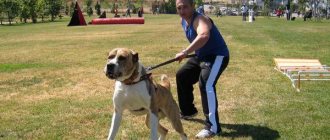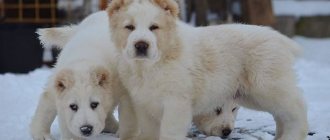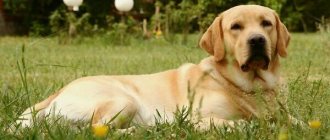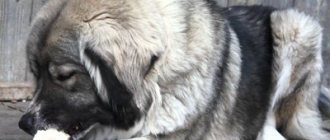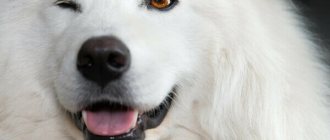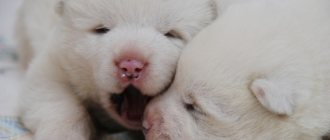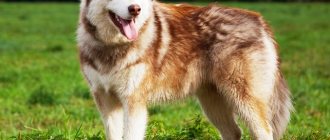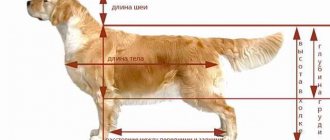The Alabai puppy (a Turkmen variety of the Central Asian Shepherd Dog) is a small but large child - a serious breed of dog. Alabai is a large breed of dog, not suitable for all people, requiring a certain responsibility in raising and caring for the animal. Quite popular in Russia and neighboring countries. Official recognition took place in 1993, when the first breed standard was developed.
The animals themselves are ancient representatives with a centuries-old history of formation. The dog has an interesting and at the same time harsh character, which requires control from the owner; it is necessary to start raising puppies from a very early age, which will help to avoid difficulties in the future.
Appearance
Representatives of the Alabaevs grow into large animals of impressive size. They have a heavy and powerful skeleton, a large head of almost rectangular shape. The paws are powerful, straight, strong with good muscles.
- The coat is thick with a pronounced thick undercoat. The eyes are not large, oval, widely set, the gaze is direct and confident.
- The massiveness and great weight of the dog gives the appearance of obesity and slowness, along with a clear feeling of his strength. In reality, it is a powerful but agile dog with a fairly dangerous bite force and other physical characteristics.
- Weight of an adult dog: – from 70 to 85 kg. Height for an adult Alabai dog at the withers: from 65 to 75 cm, girls are less bulky, but also large from 60 to 75 cm.
- There are several varieties based on color: black, red, fawn, gray, brindle representatives.
Asian Shepherd puppies, at a young age, are funny - despite their large size, they look funny, look like well-fed bears, black, red and gray-white babies look especially impressive.
During this period, special attention is paid to the baby’s nutrition and education. At 2-3 months, the child leaves for a new home from the breeder, where all the fun begins.
A small puppy creates the impression of a large and impressive animal, even at a very young age.
Like all Central Asians, kids also have distinctive external characteristics:
- The ears are located at the same level as the eyes;
- Strong neck;
- Wide head;
- The transition from the bones of the forehead to the muzzle is clearly pronounced;
- Large nose;
- Paws are oval and large;
- The croup is wide, the stomach sags a little after feeding;
- Puppies have dark and round eyes, set wide apart;
- The wool is hard and slightly rough to the touch.
Feeding schedule
The example is given for a puppy from 2 to 4 months. The main meal should be carried out according to the schedule:
- 8 am;
- 12 a.m;
- 17 pm;
- 10 p.m.
Veterinarians recommend making milkshakes for your pets, which will be an excellent snack between meals. Their recipe:
- 0.5 l of milk;
- 1 tbsp. l. honey;
- 1 yolk.
Combine all components and mix thoroughly. In terms of time, the cocktail should be given at 10 a.m., 2 p.m. and 7 p.m. It is better to use goat milk for cocktails, but if this is not possible, you can also use cow milk. It is also necessary to regularly monitor the puppy’s health; the slightest changes in his stool require immediate medical attention.
Advice for the owner! The adult Alabai dog is famous for its beautiful posture, which needs to be developed from childhood. To do this, you need to purchase a special feeding stand. It can be adjusted as the puppy grows.
Newborn baby
In appearance, the puppy looks like an oblong barrel, with a round belly, its eyes are closed, and its weight is approximately 300 to 500 grams.
Month
In his first month of life, the baby should gain a double or even triple weight gain - from 1.5 to 4. Height at the withers is approaching 25 cm.
2 months
By two months of life, the Alabay can already weigh up to 10 kg, which makes it visually similar to an adult, medium-sized dog. During this period, the skeleton is formed, it is important to provide high-quality nutrition.
3 months
Already large visually, weight up to 15 - 18 kg, height up to 40 - 45 cm, they are beginning to actively develop, character formation is taking place.
4 months
Height reaches 50 - 55 cm, and weight up to 30 kg, external changes gradually begin to occur, stretches in height, becomes narrower and a little awkward. Maybe a little thin. There is no good muscle mass yet.
5 months
A slight decrease in activity, the increase is not significant - height by 3 - 5 cm, weight from 4 to 8 kg.
6 months
The period when a puppy begins to turn into an adult dog, it grows wider, looks more powerful, and gradually builds up muscles. Weight can reach 45 kg, and height up to 65 cm.
From 7 to 10 months
It begins to approach the indicators of an adult dog, does not change so quickly, and begins to grow in width and gain lean muscle mass.
1 – 1.3 years
A fully adult Alabai, which changes slightly in the direction of thickening and muscle gain, no longer grows, is considered an adult.
Alabai puppies grow up to the age of 11 - 12 months, only at this moment the pet is considered fully formed.
Alabai puppy development by months
Despite the different rates of growth and weight gain in Central Asian Shepherd puppies, there is a certain dependence of these parameters on the age of the growing pet. The owner of a baby under the age of one year is recommended to carry out control weighing and measurement of the dog’s body girth once a month to monitor the harmonious development of the animal. Significant growth retardation or excessive weight gain before the age of 8-10 months can still be corrected with nutrition and medications; after a year, it is no longer possible to change the formed skeleton.
Weight and height of Alabai at birth
Newborn Central Asian Shepherd puppies have a round, dense body with short legs and a large rounded head. The babies are still quite clumsy and look like small fluffy “barrels”. The weight of the Alabai at birth must be at least 350-550 g, otherwise the babies are considered weak and are subject to culling.
Alabai puppy age 1 week
One month
Provided there are no congenital pathologies and sufficient breast milk production, a lactating bitch will experience a significant increase in weight and height of furry pets during the first 4 weeks of life.
1 month
The weight of a one-month-old Central Asian Shepherd puppy is already 3-5 kg with a height of 25-30 cm. Babies at one and a half months resemble well-fed, nimble lumps with soft fur; at this age it is still impossible to distinguish boys from girls.
Video: month-old Alabai puppies
Two month
Starting from 2 months, intensive growth of bones and muscles occurs, due to which there is a significant increase in the dog’s height and weight and external changes. A two-month-old puppy should be at least 35 cm at the withers and weigh 9-10 kg. An increase in body weight occurs due to the deposition of calcium salts in the growing skeleton. At this age, babies of the same litter may have different rates of growth and weight gain, which, with quality feeding and care, is not a pathology or a cause for concern.
2 months
Three months
In a three-month-old pet, the formation of the musculoskeletal system continues; the dog grows to 40-45 cm, weighing 15-20 kg. The bones of a Central Asian Shepherd puppy at this age are still very fragile due to the immaturity of bone tissue, so training and active games with adult dogs are excluded.
3 months
At 3 months, Alabai resemble cheerful, well-fed bear cubs due to their dense build, round massive head with cropped ears.
Video: Central Asian Shepherd puppies are 3 months old
Four months
At 4 months, Central Asian Shepherd Dogs experience a noticeable lengthening of the limbs and body due to intensive skeletal growth. During this period, the bones are strengthened due to the formation of dense bone tissue. A four-month-old Asian already weighs 25-30 kg with a height at the withers of 50-55 cm. The body of the young animal acquires elongated and narrow graceful outlines with a rounded large head.
Five months
At the age of five months, further growth of the skeleton and formation of the chest occurs, although in most individuals there is a decrease in the intensity of the growth rate. At 5 months, the pet reaches a height of 55-58 cm and weighs 35-37 kg.
5 months
It is very important at this stage to prevent your pet from becoming obese to avoid the development of pathologies of the musculoskeletal system as a result of increasing load.
Video: Alabai puppy 5 months old
Six to eight months
6 months
If up to six months a young dog grew mainly in height, then from 6 months the formation of muscles and growth in width begins. At the age of 6-8 months, an increase in skeletal growth occurs with the final formation and strengthening of the bones. In the same period, muscle growth is observed, due to which the thin Alabai with long thin limbs gradually takes on the appearance of an adult dog with massive body contours. A six-month-old puppy already looks like a young “calf”, having a height of 60-65 cm and a weight of 35-50 kg.
Video: Alabai age 7 months
Nine to twelve months
At 9-10 months, Asians complete bone growth and the formation of the chest; further increase in body weight occurs due to muscle growth. The thin body and limbs gradually become overgrown with round, elastic muscles. At this age, based on exterior differences, it is already possible to accurately determine the gender of the dog. Males grow up to 80 cm with a weight of 70 kg, have a massive overweight body and a large bear-like head. Bitches have a height at the withers of about 70 cm with a body weight of 60 kg and a more graceful silhouette.
12 months
One or two years
At 1-2 years of age, further formation of exterior characteristics occurs due to the development of muscles. This process may be accompanied by a slight loss in height due to relaxation of the ligamentous apparatus, but the result is a harmoniously harmonious dog with a powerful body and outstanding appearance. The smartest large pet at this age can reach 75-95 cm at the withers and weigh 75-80 kg.
1.5 years
Two years and older
The formation of the exterior in males can last up to 2-3, and sometimes up to 5 years. In females, this process stops at 9-18 months at the first heat. Early mating in both sexes negatively affects the development of the locomotor-muscular system. The dog continues to grow in width due to increased muscle mass. At 2–3 years, most individuals complete muscle growth and the final maturation of the nervous system occurs. The weight of an adult Alabai is 65-80 kg, depending on gender, the height at the withers reaches 70-80 cm. Although there are handsome ones with a height of about 96-98 cm, which, when standing on their hind legs, are taller than any person!
Alabai over 3 years old
When raising a Central Asian Shepherd, it is necessary to remember the uneven growth rate and the average height and weight of the dog depending on age. The parameters of the parents of growing young animals are of no small importance. A graceful, stately beauty can be raised from a clumsy little puppy only if it has good heredity, high-quality feeding and care, and competent regular physical activity.
Security guard character
Alabai (Central Asian Shepherd) puppy - at an early age, curious and easy-going. The child eats a lot, sleeps a lot and plays. By themselves, they are quite restrained, but by 3–4 months they begin to show increased activity.
Even at this age, they are already beginning to show themselves as guards, copying their mother’s behavior and showing their individual characteristics.
Despite the fact that they are kids, you can see in their behavior: not only interest, but also wariness. They are sociable and friendly, they want to play a lot, communicate with a person and test their strength.
Right now, the dog is beginning to realize what he can and cannot do. It is necessary to begin the process of education from the first days of his appearance in the house. This is an intelligent animal, which has especially pronounced guarding abilities; the more you pay attention to its socialization, the faster it will pass.
With age, they become more wary of strangers, but do not lose their sociability; it is enough to show that the owner treats the stranger well, and they will immediately change their anger to mercy.
- They will not show increased aggression without a reason, but you should still be careful about contact with strangers; it is better to control the process personally.
The only thing that needs to be taken into account is that males do not particularly like their fellow tribesmen; various skirmishes and fights between them are possible. At an older age, such contacts should be avoided.
Alabai is first and foremost a guard, and only then a friend and companion; he will need to devote a lot of time, not only for care, but also for education and training, although they are very disposed towards her. Turkmen Shepherd Dogs, for a long time, have become world famous and have been famous for their guarding skills and ideal performance indicators in this area.
Puppy food
A balanced diet plays an important role in a dog’s health.
What to feed at 1 month
At this age, feeding should be done every 3 hours, gradually increasing the intervals between meals. The basis of nutrition at the age of 1 month is dairy products, which should be supplemented with vegetables, cereals, sour cream, and vegetable oil in small quantities.
Diet at 2 months
In addition to vitamin and mineral supplements, the diet of a two-month-old Alabai should include:
- meat - 160 g;
- cottage cheese - 290-310 g;
- curdled milk - 230-250 g;
- cereals - 100 g;
- vegetables - 60 g.
Nutrition at 3 months
The puppy's energy needs and appetite increase by the age of three months. For a weekly diet you will need the following volume of products:
- 360 meat products;
- 500 ml yogurt;
- 650 g offal;
- 330 g cereals;
- 300 g vegetables;
- 160 g dark bread;
- 50 g bran;
- 10 ml vegetable oil.
Attention! The puppy should be given a boiled chicken egg about 2-3 times a week.
Further diet
By the age of five months, the number of meals is 4 times a day. Meat also dominates the diet. During the period of 5-8 months, it is customary to feed the dog 3 times a day.
From the age of eight months, two meals a day are introduced; for one meal, the volume of meat should be 550-700 g.
Natural feeding
When feeding naturally, it is important to include in the diet not only meat, but also dairy products, cereals, fermented milk products, bran, and vegetables. You should also ensure constant access to a bowl of water. From 10 months, your puppy can be given raw soft meaty bones.
Important! It is recommended to monitor the amount of food you eat, as overeating is not advisable.
Switching to dry food
It is recommended to switch animals to ready-made dry food no earlier than two years of age. The brand should be chosen individually so that the components do not contribute to allergic reactions.
In any case, you should give preference to high-quality products, the super premium category.
Rickets in puppies
Puppies up to 12 months of age are susceptible to this disease. The disease occurs as a result of a deficiency:
- vitamin D;
- calcium;
- phosphorus.
Signs of rickets in puppies:
- inhibited reaction;
- fatigue often occurs;
- oppression;
- the condition of the coat deteriorates.
Treatment involves adjusting the diet and taking additional mineral and vitamin preparations as prescribed by the doctor.
Crooked front paws
Most often, curvature of the paws occurs due to genetic abnormalities. Correcting the situation is extremely difficult, often impossible. Remains to love and care for the pet.
Curvature of a pet's paws
Care and maintenance
A small bear cub requires special care at a young age, at this time they are especially vulnerable. Until 2 months, they are not yet fully vaccinated, so it is worth excluding contact with strangers and other animals.
After activation, the pet can already go outside and begin socialization. First, you need to accustom him to a leash and collar, and then start going out into crowded and noisy places, allowing him to communicate with strangers and other animals.
The pet must have a warm and cozy place. Must be purchased in advance:
- Bowls;
- Stern;
- Toys;
- Claw clipper;
- Comb;
- Shampoo;
- Muzzle.
The baby is not yet ready to live completely outside, so until he is 5–6 months old he will need a separate place in your home. During daylight hours, you can leave him in an outdoor enclosure, provided there is enough space. In winter, it is better to refrain from long stays until the pet grows up.
Bathing is not mandatory, washing only if it gets dirty, but wiping the paws after a walk is mandatory.
It is necessary to accustom him to cutting nails from early childhood; he must be ready for such a procedure and know it from childhood. Train him to use a muzzle as well.
- An important point in care is regular vaccinations and vaccinations, treatment of fur against parasites, as well as anthelmintics.
Any change in behavior, refusal to eat, apathy, external changes, foreign smell, all this indicates health problems. It is recommended to immediately contact a specialist and find out the cause; do not self-medicate; take the dog to the veterinarian.
Childbirth and care of Central Asian Shepherd puppies
Your pet is mated and there are only a few days left before giving birth.
The chosen place suits both of you and the bitch happily sleeps there after walks. It's time to stock up on dull scissors, a pile of clean rags and old newspapers, find a dozen small terry napkins or two or three towels, boil a skein of raw thread, sterilize dull scissors (be sure to be dull!). Don't forget to check the bar and first aid kit for cognac, valerian and Vaseline and wait for labor to begin. It is better for impressionable owners to arrange a visit from an experienced breeder or veterinarian in advance. But I would like to note that this is an extreme measure in relation to females of the Central Asian Shepherd breed, whose birth usually proceeds without any special complications. In about a day, a clot of brownish mucus comes out of the loop - a plug. This is one of the signs that your due date is approaching. If the bitch is very attached to her owners, try not to leave home in the week when the puppies are expected - bitches are able to regulate their labor and can give birth to a premature or, on the contrary, post-term litter. If you are lucky, the birth will happen during the day. More often, Asian women give birth to puppies at night, so as not to attract unnecessary attention to themselves. Before childbirth, the loop becomes soft, the loop stretches, and the stomach seems to disappear, moving from under the ribs into the pelvic region of the peritoneum.
Central Asian Shepherd puppies are born with amniotic sac. Inside it is fetal fluid, which helps the puppy pass through the loop as quickly as possible. For dogs, the birth of puppies in a breech position (that is, tail first) is not a pathology, so if it is not the head that emerges from the loop, but the hind leg and tail, do not be alarmed. Only for upright people this can be a problem.
Often the first blisters come out empty, filled only with amniotic fluid. This is normal for multiple pregnancies - some fertilized eggs are not viable and are eliminated during pregnancy, causing these blisters to appear. The color of amniotic fluid is usually straw-colored. If the puppies are post-term or if there are dead puppies in the litter, the waters may have a greenish tint. Sometimes blood appears in the fetal fluid. However, such bleeding usually goes away quickly.
The most difficult thing for a first-time mother is the birth of her first puppy. The loop is not yet fully stretched, so the puppy does not come out of it quickly enough. Vaseline will help the baby slip out of the loop faster and injure the bitch less.
Usually the bitch herself licks the puppy and gnaws the umbilical cord. If she is in no hurry to do this, remove the film from it yourself, starting from the head, and cut the umbilical cord with blunt scissors, imitating the work of the bitch’s jaws, which do not cut, but grind it, preventing bleeding.
The first 3-5 puppies are usually born every 10-20 minutes. Then there may be a pause, during which it is better to take the bitch outside to the toilet, taking a terry towel with you, so that, if necessary, you can pick up the puppy born during the walk. Walking, like suckling puppies, is an excellent method to stimulate labor without drugs; in addition, a full bladder and intestines interfere with labor, causing the Asian woman to worry.
Upon arrival, labor resumes, but puppies are now born somewhat less frequently - intervals can increase to 40 minutes. It often happens that a bitch gives birth to her last puppy in the morning, when the tired owners go to bed.
It is advisable to write down in a notebook the weight of the puppies, the time of birth, their gender and color, with notes that arise during the birth. These notes will then become interesting reading for owners and a calling card for each puppy.
Asian newborns weigh between 400 and 700 grams. In small litters, puppies may be larger and there is a risk of cervical rupture. Therefore, it is not recommended to overfeed the bitch in the last week before giving birth.
Usually the bitch licks the babies dry, and at this time they crawl for mother's milk, very firmly sucking on the mother's nipples. If a newborn Alabai puppy is choked and shows no signs of life, you should take him in a towel with his head away from you and firmly lower your hands down so that the liquid comes out of the baby’s respiratory tract under its own weight. This procedure is repeated several times until the baby gives a voice and starts sneezing. After revival, one drop of cognac or whiskey can be placed on his tongue as a stimulant.
Anxiety in the bitch, an increase in temperature to 40 degrees or more, black foul-smelling discharge, weak labor, or a puppy stuck in a loop are reasons for an urgent visit to a doctor, with whom it is better to arrange a possible visit in advance. However, such cases in the breed are the exception. Asian women are excellent mothers and their births most often occur without complications.
The next stage for Central Asian Shepherd puppies is docking. This procedure is purely custom in nature and is designed to improve the quality of life of future working dogs. It is carried out on the third to fifth day. Weak puppies can be docked later. At the same time, dewclaws on the toes, if present, are removed. It is better to entrust docking to an experienced specialist who is familiar with the breed characteristics of Asians. After it, the mother bitch licks the wounds on her own and they heal until the morning. The strength of the nervous system of Asian calves can be preliminarily assessed by their behavior during docking. The most balanced and insensitive to pain endure the procedure in silence and only grunt or try to grab the cupper’s finger.
Monitoring the weight of puppies allows you to choose the right time to give anthelmintics to puppies for the first time. This happens in about two weeks. Once the puppies have stopped gaining weight for several days, they should be given an anti-roundworm suspension. After two weeks, the procedure is repeated.
Issues of education and training
Alabai is a serious dog, before raising him, decide who will take responsibility, the dog should have only one owner, who will be responsible for raising him. Usually they obey only one of the family - for them this is the most important and main person, their master.
Education and training also begin in puppyhood, and commands are learned progressively. First, learn simple commands: “sit”, “near”, “to me”, “lie down”, “not allowed”.
The time to study gradually increases and the complexity increases. In adolescence, from 8 to 11 months, it may show lack of restraint and stubbornness. This is fine. The owner needs to show patience and restraint, do not shout or use physical force.
- As encouragement, use goodies in the form of: cheese, food, white chicken meat (cooked).
The best option would be to undergo training with a specialist, where not only the dog, but also the person will be able to understand everything necessary for better contact with the pet. You can go to a sinologist from 3 to 4 months, and then continue on your own.
- It is not recommended to purchase this breed for people without experience in raising large dogs. But on the other hand, if you really want to, you can try, but it’s better to start training right away with a dog handler.
At home, also be persistent, do not allow chewing on hands or playing with feet, exchange for a toy, focus attention on the objects, not the person. You should not allow jumping or encourage violent expressions of emotions.
Caring for ears, eyes, teeth, claws
To make life easier for the animal, you should regularly examine your pet and clean its vital organs.
Ears
It is necessary to examine the dog’s ears every day for signs of:
- redness;
- swelling;
- heavy discharge;
- mud;
- unpleasant odor;
- discoloration in some places.
You should clean your ears every 3-4 days. If sulfur has not yet accumulated, you should not disturb the puppy again.
Attention! In Russia, ear cropping of white or black Alabais is not a mandatory procedure; the owner decides the issue independently.
Alabai eyes
If discharge appears from the dog's eyes, it is necessary to wash them with chamomile decoction or tea. It is recommended to show the animal to a veterinarian.
Ears and eyes require constant care
Teeth
You can clean plaque from pets using special toys or large bones, as well as a special toothbrush. The puppy should get used to the procedure from early childhood; in adulthood, he will know what the device can look like.
To remove tartar, you should contact your veterinarian.
Claws
If the claws do not gradually wear off, you need to shorten them using special forceps yourself or contact a veterinary clinic.
Feeding rules
For large breed dogs, both natural and dry feeding is suitable. Dry food in this case is more recommended, since it already contains everything essential for the growth and development of the animal.
Premium food for large animals “Go” “Proplan” and medium type food with a lower cost are suitable. Adult dogs eat 2 times a day, kids should eat 4 - 5 times a day in small portions.
Calculation based on the weight, age and activity of the animal. Breeders generally, when purchasing, already recommend a certain type of food that the puppy ate, it is better to leave it. If you are thinking of changing, then do it gradually over 2 weeks. It is important to ensure access to drinking water – not limited.
For natural feeding, the following set of products from which the diet is formed is suitable:
- Lean, boneless meat (exclude pork);
- Sea fish (cleaned without bones);
- Dairy products (cottage cheese, cheeses, low-fat kefir);
- Porridge (buckwheat, rice);
- Fresh vegetables (ground or finely chopped);
- Fruits;
- Vegetable fats;
- Bone flour;
- Sometimes the eggs are fresh.
Exclude tubular bones, sweets, chocolate, pasta, grapes, citrus fruits. How the pet will grow and develop, as well as its physical condition, depends on the quality of nutrition. It is recommended to consult with the breeder and veterinarian when feeding natural products for the correct and competent calculation of proteins and carbohydrates.
- Approximate calculation: 30 grams of protein per 1 kg of animal weight, 30% will be spent on cereals, vegetables, and fruits. You will also need mineral complexes and vitamin supplements.
Food preparation ideas
The option of feeding the puppy food remains popular. Each package of the selected food contains recommendations regarding feeding portions. It depends on the age category and weight of the Alabai.
Dry food can be divided into 4 parts from the main daily portion (approximately 50 g) and filled with water in a 1:1 ratio. Complete swelling of the product will occur in about 2 hours, although each food is different. We transfer the food into a bowl and add meat or fish there, which have been ground into minced meat. To prepare them, you can use a meat grinder.
It's a good idea to add vegetables to add variety to your dishes. They also need to be crushed with a blender so that the puppy cannot leave them uneaten in the bowl. Approximate proportion 1:5 per serving. To the stew you need to add ½ teaspoon of vegetable or butter. The owner can independently regulate the amount of serving based on the puppy’s mobility.
For breakfast, you should offer your pet a nutritious dish that contains calcium and other beneficial microelements. The soaked food should be mixed with cottage cheese or kefir. It’s a good idea to add fruits, berries and nuts in the amount of 1/5 of the entire serving. Then you should dilute the resulting mixture with a teaspoon of oil. This dish is recommended for breakfast as it is very nutritious and after the night the puppy needs a hearty breakfast.
The third and fourth times it is recommended to feed meat or fish, alternating them.
Your puppy's diet must include nuts, at least in small quantities. There are no restrictions on the types of nuts. You can give cashews, hazelnuts, walnuts. It is advisable to prepare stock for dishes in advance. To do this, a mixture of any nuts must be crushed in a blender and poured into a separate jar. You need to add one teaspoon to each serving. It is better to store the jar in the refrigerator or other dark and cool place.
An important rule is that you cannot prepare food in advance and leave it in the refrigerator. All portions must be fresh and prepared immediately before consumption.
Sometimes, for the growth and development of a puppy, it is recommended to prepare cottage cheese with a high calcium content. To do this, take a liter of milk and add 4 tablespoons of a 10% calcium chloride solution. Then drain in a colander and strain.
How to choose a baby
Before you make your final decision and choose a puppy, you need to pay attention to the following:
- General appearance, its activity and location;
- Meet your parents, find out about their health;
- Look at all your fellow tribesmen;
- The character is already emerging, it’s worth staying a little and observing;
- External data - the correctness of the bite, how the baby looks in a stand, the condition of the coat, the presence of vaccinations.
Find out in advance about upcoming matings and look at the pedigrees; it is better to personally meet both the breeder and the mother. Decide in advance whether you want to choose a female or a male.
- Girls are more flexible than boys, but they are more often involved in breeding and, accordingly, are more expensive. For families with small children, a girl is more suitable.
Contents of Alabaev
It is worth discussing how to properly care for puppies when the birth of the Alabai is over and the kittens will go to new homes in the near future.
Vaccinations
To ensure your pet's health, you need to follow the vaccination schedule:
- At the age of 5-8 weeks, the first vaccination is done in 2 stages, if the mother was vaccinated before mating.
- More often, breeders tend to give the first vaccination at 2 months. Revaccination should be carried out at intervals of 1-2 weeks.
Important! The injection should only be administered to an absolutely healthy animal until the baby teeth fall out.
Grooming
You should not bathe the animal too often, because the fur is resistant to dirt. It is enough to carry out the procedure 2-3 times a year using special shampoos. Dead fur should be combed regularly; the peak of shedding occurs in the spring.

